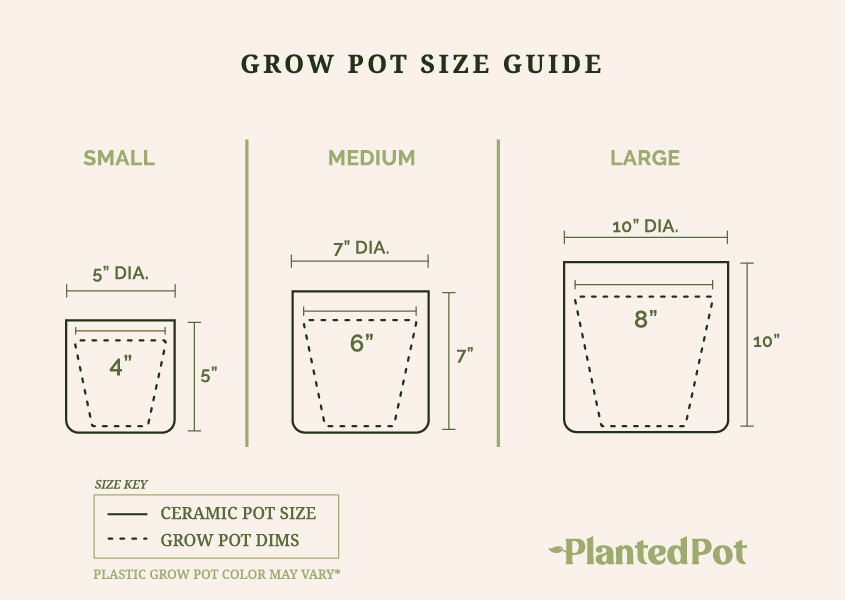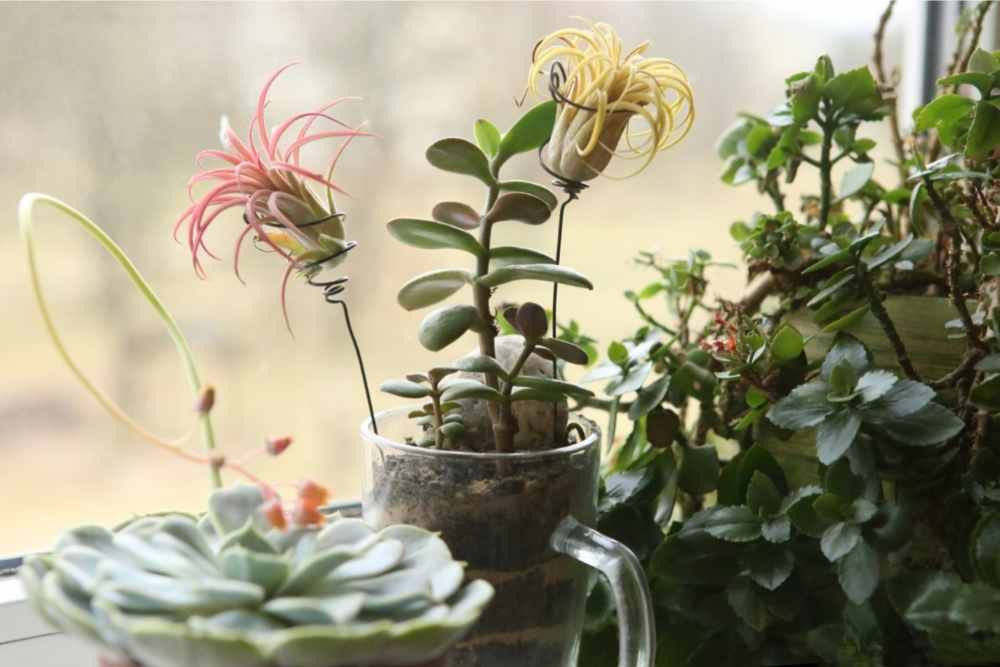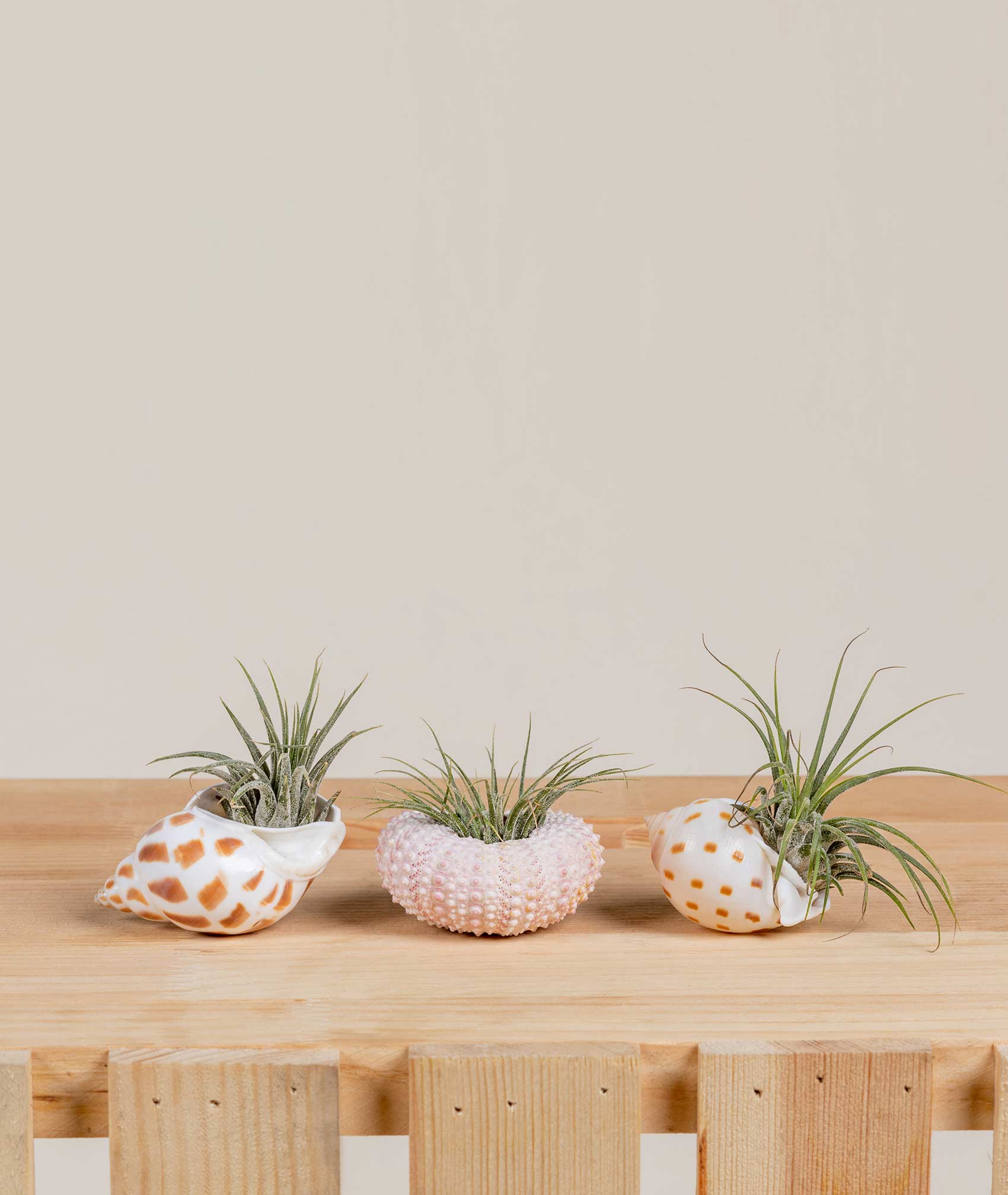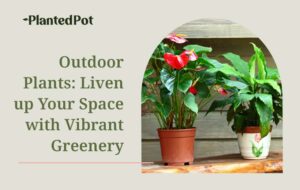
Tillandsia Ionantha
$25
 Plastic grow pots come in different colors, you may receive a black or rust colored pot.
Plastic grow pots come in different colors, you may receive a black or rust colored pot.
Want to be notified when this product is back in stock?
The Tillandsia Ionantha is the most popular Air Plant around, and it adds immense charm to any desk or window sill when growing in a seashell! There are about 650 species of Tillandsia plants, and most of them are epiphytes (they grow on surfaces). Being an epiphyte, Air Plants love to be grown in glass bowls, on tree bark, or inside of seashells. The Ionantha is native to Mexico, Costa Rica, and certain areas of South America. This natural habitat is the reason for its warm, humid care requirements. However, what people love most about Air Plants is that they are not picky. They grow anywhere, get most of their water and nutrients from the air around them, and don’t even need to be potted in soil.
Bright, indirect sunlight.
Water once or twice a week. Make sure to shake off any excess water before setting them out to dry.
50°-90°F
Related Products
Tillandsia Ionantha
If you’ve been searching for the perfect plant to round out your collection, look no further than the Tillandsia Ionantha (also known as the Tillandsia Ionantha Guatemala). Though big in name, the T. ionantha plant is a palm-sized, pointy-looking plant that almost resembles a sea anemone.
These plants are often remembered for the beautiful gradient of colors that they put on display. While they are mostly green and sometimes silver-toned, they bloom once in their lifetime, flaunting vibrant pink, red, and purple tones at their tips and tallest points. Though they may look sharp, these beautiful plants are not at all dangerous and make a great addition to anyone’s indoor garden or outdoor patio area. Let’s take a look!
What is a Tillandsia Ionantha?
Tillandsia Ionantha plants are a species of air plants! They don’t grow in soil and instead absorb moisture through their leaves. One of the best parts about having an air plant is that you can place it almost anywhere — as long as it fits comfortably and can receive good air circulation, it’s likely to be completely happy.
Many people love displaying air plants in finished wood receptacles or in hollowed glass globes so that they can be marveled at in their entirety from any angle. You can also train new air plants to grow off trees or tree branches with help from a little plant-safe glue.
Basic Air Plant Facts
Origins: Central region of Guatemala and in Central and South America. They were also introduced in and are often found in Florida.
Native Habitat: They thrive in tropical climates, where heavy rainfall and constant humidity are prevalent.
Proper Name: Tillandsia Ionantha Guatemala (commonly referred to as Tillandsia Ionantha or T. ionantha for short). “Tillandsia” is the plant’s genus (or plant family), and “Ionantha” roughly translates to mean “violet flower.”
Nicknames: “Ionantha Guatemala” and “the Blushing Bride” due to their colorful reddish blooms.
Air Plant Care Instructions
- Plant Size: Healthy plants are normally 3″ tall; they can grow from 2-6 inches and spread 2-4 inches wide.
- Lighting: Prefers bright and indirect light. Though T. ionanthas like bright light, too much exposure to direct sun can harm the plants’ leaves. Because of this, the Ionantha air plant fares best when placed in an east or west-facing window. Fluorescent lights also work, as long as you remember to turn them off before bed each night, so you don’t overexpose your plant.
- Watering: Air plants can be watered once or twice a week by submerging them in standing water. Remember to gently shake off any excess water after soaking your air plant before setting it out to dry.
- Temperature: Thrives most in warmer temperatures (from 50-90°F).
- Humidity: Favors more humid conditions. You can create a more humid environment for your plants by purchasing a small humidifier to keep near them or by placing them on wet rocks. The T. ionantha can also benefit from regular misting to help their leaves maintain adequate moisture levels.
Feeding Your Air Plant
Since air plants don’t need soil to survive, they often miss out on added nutrients that other plants are normally exposed to.
By adding fish emulsion fertilizer to a mist bottle or using a foliar fertilizer mist (for example, a low-nitrogen bromeliad fertilizer), you can give your plants extra nutrients, and further supplement their health.
Propagation: Caring for Pups
Similar to many other Tillandsias and succulents, a single Tillandsia Ionantha mother plant can yield 1-3 pups after they begin blooming. They can also propagate through seeds, but this can take 2-4 years to accomplish, whereas pups will begin to grow only 6 months after being trimmed from their mother plant. Simply place the pups into water, and watch them grow!
Why Choose a Tillandsia Ionantha for Your Home?
While air plants have generally become more popular, the Tillandsia Ionantha is one of our favorite air plants to keep at home, and we think it’ll become one of yours, too.
They’re Easy to Maintain
Air plant care is generally pretty simple, so Ionantha plants are fairly easy to take care of — this makes them a great addition to any existing collection, as well as a great starter plant for newer plant friends. Because they don’t require soil, they’re also easily movable and don’t require much clean-up in their care routines.
They’re Good for the Atmosphere
Like most other plants, the Tillandsia Ionantha can positively affect a space’s air quality. While houseplants are only generally able to improve indoor air quality by 0.9-9%, because the T. ionantha is so small, you can easily boost this percentage by buying them in groups.
They’re Small in Size
T. ionanthas are perfect for any space because of how petite they are in size and look great paired up or in a cluster formation. We also love how they look when placed singularly in a terrarium or on a bookshelf next to our favorite knick-knacks.
And Honestly? They’re Pretty!
If their economical size isn’t enough, their silvery-green tones can blend in with almost any neutral tone or aesthetic, and they add a vivid pop of color to any space when they bloom.

Are Tillandsia Ionantha Plants Good Indoors & Outdoors?
Tillandsia Ionantha plants can be kept both indoors and outdoors but should be kept indoors during winter and colder seasons. They prefer summer temperatures and prosper in more humid environments.
As long as they have access to sufficient light and can be kept out of direct sunlight, they usually fare well in varied home environments and can be relocated as needed.
Are Tillandsia Ionantha Plants Pet and Children Friendly?
Tillandsia Ionantha plants are both pet and child-friendly. They’re also non-toxic, which makes them completely safe to keep anywhere in your house.
Because they don’t require soil and don’t necessarily need to be kept in a pot or container to survive, you won’t have to worry about mess or clean-up if your Ionantha is ever knocked over, either!
Tillandsia Ionantha Plant Family Relatives
T. ionantha air plants are part of the Tillandsia grouping of the bromeliad plant family — more commonly known as the pineapple family! Bromeliads are often characterized by their single seed leaf, and there are currently over 3,000 identified species.
These species are categorized into about 70 different groups. Some well-known bromeliad plant family types include:
- Aechmea: These are very common, do well indoors, and prefer a constant source of water to drink from.
- Guzmania: Can grow to be over two feet wide and with yellow and white flowers.
- Portea: Unlike tillandsias, porteas grow to be very large and need a lot of space to flourish happily.
Plant Types That Are Similar to the Tillandsia Ionantha
Though there are hundreds of different Tillandsia species, some are much more similar to our friend T. ionantha than others:
- Tillandsia Veluntina: T. Veluntinas are air plants that are around the same size as T. ionanthas. They also have very similar structures and care routines, so if you love T. ionanthas, you’ll probably love these, too!
- Tillandsia Aeranthos: Unlike the T. Ionantha, the T. Aeranthos uses roots to support itself and can grow much taller. Their flowers, however, are just as rich in color as the T. ionantha’s and are rich in pink and violet tones.
- Tillandsia Usneoides: While not very similar in physical structure, the T. Usneoides is just as commonly found as the T. ionantha. It also likes to grow on trees and branches but is generally much larger and has a more billowy and soft appearance, like moss.
Final Thoughts – Tillandsia Ionantha
Though they may be small, the Tillandsia Ionantha air plant is mighty and beautiful! And on top of that, with how easy they are to care for, we think they’re essential to every plant lover’s collection.
Are you in the market for more new plants or other plants that are easy to care for? Visit the Learn and Plants sections on the Planted Pot site to read more about our favorite house plants and to discover more blooms that are right for you!




Reviews
There are no reviews yet.